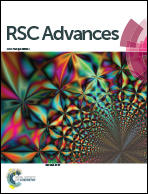High proton conductivity behavior in a 2D metal sulfite constructed from a histidine ligand†
Abstract
In the presence of the amino acid histidine, an inorganic–organic hybrid metal sulfite, Zn2(SO3)2(C6N3O2H9)2·H2O (1), has been prepared under hydrothermal conditions. Single-crystal X-ray diffraction analysis reveals that 1 shows a 2D layer framework built up from a classical second building unit (S4R), and bridged histidine molecule. Notably, it is the first report of a metal sulfite in the presence of an amino acid molecule. A 1D H-bonding array can be constructed by the H-bonding interaction between histidine molecules and sulfite groups. Moreover, a new function of metal sulfite for proton conduction was investigated by alternating-current impedance analysis. The results demonstrate that compound 1 shows a high proton conductivity of approximately 10−3 S cm−1 at 348 K and 98% relative humidity.



 Please wait while we load your content...
Please wait while we load your content...